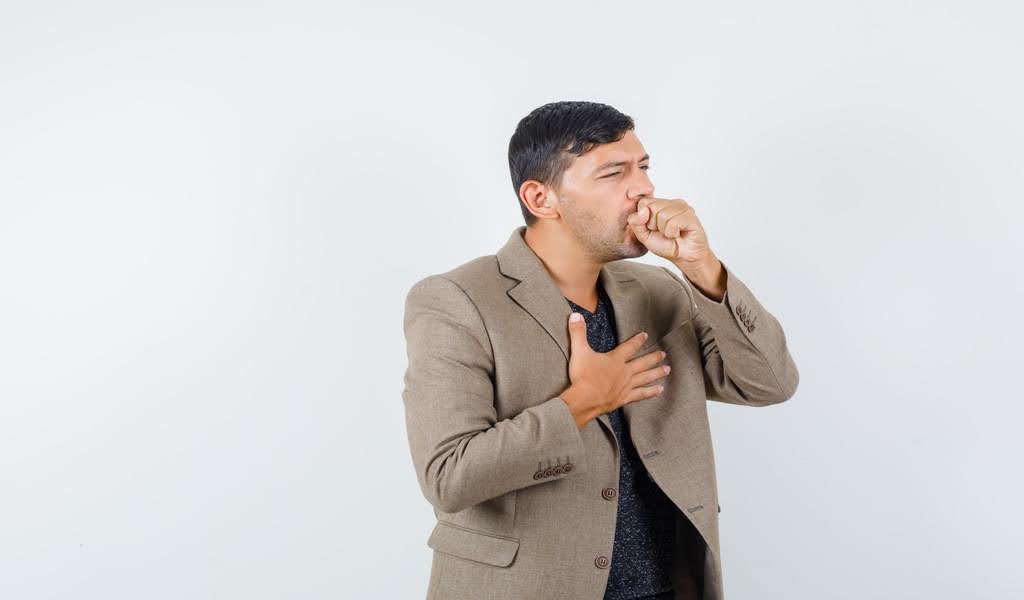Can an AI Doctor Prescribe Antifungal Medication?
Yes, AI doctors can help you get prescription antifungal medications. While the AI itself cannot legally prescribe, AI doctor platforms connect you with licensed physicians [...]
Read More
Medically reviewed by Abhijit Bhattacharyya | MD, PhD, MBA, Tufts University School of Medicine - Miami, Florida on May 30th, 2025.
 Experiencing shortness of breath after eating is a common concern for many individuals. While it may seem alarming, understanding the underlying causes can provide clarity and reassurance. This article delves into the various reasons why this phenomenon occurs, the physiological mechanisms at play, and when it may be necessary to seek medical advice.
Experiencing shortness of breath after eating is a common concern for many individuals. While it may seem alarming, understanding the underlying causes can provide clarity and reassurance. This article delves into the various reasons why this phenomenon occurs, the physiological mechanisms at play, and when it may be necessary to seek medical advice.
Shortness of breath, or dyspnea, is a sensation of not being able to get enough air. It can vary in intensity and duration, and while it often occurs during physical exertion, some individuals may experience it after meals. This can be particularly distressing, leading to concerns about underlying health issues. For many, the experience of shortness of breath can be alarming, prompting a rush to seek medical advice or intervention. Understanding the triggers and mechanisms behind this sensation is crucial for managing it effectively.
When food is consumed, the body undergoes several physiological changes. The digestive process requires increased blood flow to the stomach and intestines, which can divert blood away from other areas, including the lungs. This redistribution can lead to a feeling of breathlessness.
Furthermore, the body releases various hormones during digestion, such as cholecystokinin, which can influence breathing patterns and increase the sensation of breathlessness in some individuals.
Additionally, the act of eating itself can create pressure in the abdominal area. As the stomach expands to accommodate food, it can push against the diaphragm, the muscle responsible for breathing. This pressure can limit the diaphragm's movement, making it more difficult to take deep breaths. In some cases, individuals may also experience increased respiratory rates as the body attempts to compensate for the reduced lung capacity, leading to a cycle of discomfort and anxiety that can exacerbate the feeling of shortness of breath.
Overeating: Consuming large meals can exacerbate feelings of fullness and pressure on the diaphragm.
Food Choices: Certain foods, particularly those high in fat or sugar, can slow digestion and lead to discomfort.
Underlying Health Conditions: Conditions such as asthma, GERD, or heart disease can contribute to post-meal dyspnea.
Moreover, anxiety and stress can play a significant role in the experience of shortness of breath after eating. For some individuals, the act of eating can trigger anxiety, especially if they have had prior experiences of discomfort or panic associated with meals. This psychological component can lead to hyperventilation, further complicating the sensation of breathlessness.
Additionally, certain medications taken for chronic conditions may have side effects that include respiratory symptoms, making it essential for individuals to discuss their full medical history with healthcare providers when experiencing dyspnea.
It is also worth noting that the timing of meals can influence how one feels afterward. Eating too close to engaging in physical activity can lead to discomfort and exacerbate feelings of breathlessness. Therefore, adopting mindful eating practices, such as taking smaller bites and allowing adequate time for digestion before engaging in physical exertion, may help mitigate these symptoms. Understanding these various factors can empower individuals to make informed choices about their eating habits and overall health.
Several factors can influence the likelihood of experiencing shortness of breath after eating. Understanding these can help individuals make informed choices about their eating habits and overall health.
The position in which one eats can significantly impact breathing. For instance, lying down or slouching while eating can compress the diaphragm and exacerbate feelings of breathlessness. Sitting upright can help alleviate this pressure and promote better digestion.
Additionally, the choice of seating can also play a role; using a chair that provides good back support can further enhance posture and facilitate easier breathing. It is also beneficial to take breaks during meals to stand or stretch, allowing the body to reset and encouraging better airflow.
How quickly one eats can also contribute to post-meal discomfort. Eating too quickly can lead to swallowing air, which can create a feeling of fullness and pressure in the stomach. Taking time to chew food thoroughly and savor each bite can improve digestion and reduce the likelihood of shortness of breath.
Moreover, mindful eating practices, such as putting down utensils between bites and engaging in conversation, can help slow down the pace of eating. This not only enhances the enjoyment of the meal but also allows the body to signal when it is full, potentially preventing overeating and its associated respiratory issues.
The types of food consumed can also significantly influence breathing after meals. Heavy, fatty foods tend to take longer to digest, which can lead to discomfort and pressure on the diaphragm. Conversely, lighter meals that are rich in vegetables, lean proteins, and whole grains can facilitate easier digestion and promote better respiratory function.
Additionally, certain foods can trigger allergic reactions or sensitivities in some individuals, leading to inflammation and subsequent breathing difficulties. Keeping a food diary to track meals and any associated symptoms can be a useful tool for identifying problematic foods and making healthier choices.
 While shortness of breath after eating can be a benign occurrence, it can also indicate underlying health issues that require attention. Recognizing these conditions is crucial for effective management and treatment.
While shortness of breath after eating can be a benign occurrence, it can also indicate underlying health issues that require attention. Recognizing these conditions is crucial for effective management and treatment.
GERD is a chronic digestive condition where stomach acid flows back into the esophagus, leading to symptoms such as heartburn and shortness of breath. The pressure from a full stomach can exacerbate this reflux, causing discomfort and difficulty breathing.
In addition to these symptoms, individuals with GERD may experience a sour taste in their mouth or a persistent cough, especially at night. Lifestyle modifications, such as avoiding large meals, elevating the head during sleep, and steering clear of trigger foods, can significantly alleviate symptoms and improve quality of life.
Individuals with asthma or allergies may find that certain foods trigger their symptoms. In some cases, food allergies can lead to anaphylaxis, a severe reaction that includes difficulty breathing. It is essential for those with known allergies to be cautious about their food choices.
Moreover, the relationship between asthma and diet is complex; some studies suggest that diets rich in antioxidants and omega-3 fatty acids may help reduce inflammation in the airways. Keeping a food diary can be beneficial for identifying specific triggers and managing symptoms effectively.
Cardiac issues can also manifest as shortness of breath after eating. Conditions such as congestive heart failure can lead to fluid buildup in the lungs, making it harder to breathe, especially after meals. Individuals with a history of heart disease should consult their healthcare provider if they experience this symptom.
Additionally, the body's demand for oxygen increases after eating, and if the heart is unable to meet this demand due to underlying issues, it can lead to significant discomfort. Regular monitoring of heart health, maintaining a balanced diet low in sodium, and engaging in light physical activity can help manage symptoms and improve overall cardiovascular health.
 While occasional shortness of breath after eating may not be a cause for concern, there are specific signs that warrant medical attention. Recognizing these can help ensure timely intervention and appropriate care. Understanding the nuances of your symptoms is crucial, as they can often be indicative of more serious health issues that require professional evaluation.
While occasional shortness of breath after eating may not be a cause for concern, there are specific signs that warrant medical attention. Recognizing these can help ensure timely intervention and appropriate care. Understanding the nuances of your symptoms is crucial, as they can often be indicative of more serious health issues that require professional evaluation.
Persistent shortness of breath that does not improve with rest
Chest pain or discomfort accompanying breathlessness
Swelling in the legs or ankles
Wheezing or coughing, particularly if it is new or worsening
If shortness of breath after eating becomes frequent or severe, it is advisable to consult a healthcare provider. A thorough evaluation can help identify any underlying conditions and guide appropriate treatment options.
In addition to discussing your symptoms, be prepared to provide your medical history, including any previous respiratory issues, allergies, or chronic conditions. This information can assist your healthcare provider in making a more accurate diagnosis.
Furthermore, it may be beneficial to keep a symptom diary leading up to your appointment. Note when the shortness of breath occurs, any specific foods that seem to trigger it, and any accompanying symptoms you experience. This proactive approach can not only help you better understand your condition but also empower you and your healthcare provider to make informed decisions about your health. Remember, early detection and intervention can significantly improve outcomes, especially in cases where underlying health issues are present.
For those who experience shortness of breath after meals, there are several strategies that can help manage symptoms and improve overall comfort during and after eating.
Making thoughtful dietary choices can significantly impact how one feels after eating. Here are some recommendations:
Smaller Portions: Eating smaller, more frequent meals can reduce pressure on the diaphragm and improve digestion.
Balanced Diet: Incorporating a variety of foods, including fruits, vegetables, lean proteins, and whole grains, can promote better digestion.
Avoiding Trigger Foods: Identifying and avoiding foods that lead to discomfort can be beneficial, especially for those with GERD or food allergies.
Additionally, it may be helpful to keep a food diary to track meals and any subsequent symptoms. This can aid in pinpointing specific foods or eating habits that may contribute to discomfort.
Moreover, staying hydrated is crucial; however, it’s advisable to limit fluid intake during meals to prevent a feeling of fullness that could exacerbate breathlessness. Instead, aim to drink fluids between meals to maintain hydration without affecting digestion.
Practicing specific breathing techniques can help alleviate feelings of breathlessness. Techniques such as diaphragmatic breathing can strengthen the diaphragm and improve lung capacity. Here’s how to perform it:
Find a comfortable seated position.
Place one hand on your chest and the other on your abdomen.
Inhale deeply through your nose, ensuring your abdomen rises while your chest remains relatively still.
Exhale slowly through pursed lips, allowing your abdomen to fall.
In addition to diaphragmatic breathing, other methods such as pursed-lip breathing can also be beneficial. This technique involves inhaling through the nose and exhaling slowly through pursed lips, which can help control the rate of breathing and promote relaxation. Regular practice of these techniques not only aids in managing shortness of breath but can also enhance overall lung function over time.
Furthermore, incorporating gentle physical activity, like walking or stretching, can improve respiratory efficiency and contribute to a greater sense of well-being, especially after meals.
Shortness of breath after eating can be a perplexing experience, but understanding its causes and management strategies can help individuals navigate this issue with greater confidence. By making informed dietary choices, practicing mindful eating, and recognizing when to seek medical advice, individuals can improve their overall well-being and reduce the likelihood of discomfort after meals. If symptoms persist or worsen, consulting a healthcare provider is essential for proper evaluation and care.
Take control of your health with Doctronic. If you've ever felt short of breath after eating, it’s time to understand why. Discover expert insights and actionable solutions today—because your well-being matters!
Yes, AI doctors can help you get prescription antifungal medications. While the AI itself cannot legally prescribe, AI doctor platforms connect you with licensed physicians [...]
Read MoreUnderstanding Tirzepatide and Its Role in Diabetes ManagementTirzepatide is an innovative medication that has been gaining significant attention in the treatment of type 2 [...]
Read MoreUnderstanding Tirzepatide and Its EffectsTirzepatide is an innovative medication primarily used to manage type 2 diabetes and support weight loss. It works by mimicking the [...]
Read More